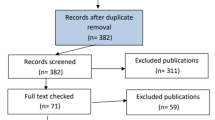Abstract
It has been shown previously that large amounts of thyroglobulin are released into the circulation by the trauma of thyroid surgery. In order to characterize the response to this challenge in patients with and without autoimmune disease, serial estimations of thyroglobulin binding capacity (AgBC) using a sensitive double antibody technique were made on 105 patients undergoing partial thryroidectomy for thyrotoxicosis (70 patients prepared medically) and nontoxic goiter (35 patients). Samples were measured the day before, the day of, and on eight subsequent occasions during the first 14 days after surgery. Three distinct patterns of change in AgBC were observed in the thyrotoxic patients: i) when elevated before surgery, it fell acutely within 48 h of operation and rose again within the first 7–10 days (8 patients); ii) it rose briskly, though transiently, when low (< 10%) before surgery (4 patients); iii) when elevated before surgery, it rose or fell gently afterwards without sudden change (7 patients). The AgBC in 51 of the Graves’ disease patients never exceeded 10% during the perioperative period, and was immeasurably low in all nontoxic goiter patients. Autoimmune thyroid disease results from a disturbance of normal tolerance to thyroid antigens, and thyroid surgery provides an in vivo model in which the response to an acute antigenic challenge may be studied. Patients with Graves’ disease showed varying degrees of intolerance to the challenge, while those with nontoxic goiter and no evidence of autoimmune disease were uniformly unresponsive.
Similar content being viewed by others
References
Hjort T., Pedersen G. Thyroid antibodies and thyroglobulin in the serum. Lancet 1: 259, 1962.
Assem E.S.K. Thyroglobulin in the serum of parturient women and newborn infants. Lancet 1:139, 1964.
Roitt I.M., Torrigiani G. Identification and estimation of undergraded thyroglobulin in human serum. Endocrinology 81: 421, 1967.
Van Herle A.J., Uller R.P., Matthews N.L., Brown J. Radioimmunoassay for measurement of thyroglobulin in human serum. J. Clin. Invest. 52:1320, 1973.
Bankhurst A.D., Torrigiani G., Allison A.C. Lymphocytes which bind thyroglobulin in healthy people and its relevance to tolerance for auto-antigens. Lancet 1: 226, 1973.
Aldo-Benson M., Borel Y. The tolerant cell: direct evidence for receptor blockade by tolerogen. J. Immunol. 112:1793, 1974.
Weigle W.O. The immune response of rabbits tolerant to bovine serum albumin. J. Exp. Med. 144:111, 1961.
Lerman J. Iodine components of the blood. Circulating thyroglobulin in normal persons and in persons with thyroid disease. J. Clin. Invest. 19:555, 1940.
Hjort T. Determination of serum thyroglobulin by a haemagglutination test. Lancet 1:1262, 1961.
Torrigiani G. Immunological responses to thyroglobulin. Ph. D. Thesis, University of London, 1965.
Uller R.P., Van Herle A.J. Effect of therapy on serum thyroglobulin levels in patients with Graves’ disease. J. Clin. Endocrinol. Metab. 46: 747, 1978.
Wilkin T.J., Swanson Beck J., Hayes P.C., Potts R.C., Young R.J. A passive haemagglutination (TRC) inhibitor in thyrotoxic serum. Clin. Endocrinol. (Oxf.) 10: 507, 1979.
Mitchison N.A. Dosage requirements for paralysis by soluble proteins. Immunology 15: 509, 1968.
Chiller J., Habicht G., Weigle W.O. Kinetic differences in unresponsiveness of thymus and bone marrow cells. Science 171: 813, 1971.
Fulthorpe A.J., Roitt I.M., Doniach D., Couchman K. A stable sheep-cell preparation for detecting thyroglobulin antibodies, and its clinical applications. J. Clin. Pathol. 14:654, 1961.
Bayer M.F., Kriss J.P. A solid phase, sandwich-type radioimmunoassay for antithyroglobulin: elimination of false positive results and semiquantitative measurement of antithyroglobulin in the presence of elevated thyroglobulin. J. Clin. Endocrinol. Metab. 49: 565, 1979.
Burnet F.M., Freeman M. Process of formol detoxication: experiments with purified staphylococcal toxin. J. Pathol. Bact. 35: 477, 1932.
Van Herle A.J., Uller R.P. Elevated serum thyroglobulin: a marker of metastases in differentiated thyroid carcinomas. J. Clin. Invest. 56:272, 1975.
Roitt I.M., Doniach D. Human autoimmune thyroiditis: serological studies. Lancet 2:1027, 1958.
Wilkin T.J., Swanson Beck J., Crooks J., Isles T.E., Gunn A. Time and tides in Graves’ disease. Their implications in predicting the outcome of treatment. Br. Med. J. 1:88, 1979.
Wilkin T.J., Swanson Beck J., Gunn A., Al Moussah M., Isles T.E., Crooks J. Autoantibodies in thyrotoxicosis: a quantitative study of their behaviour in relation to the course and outcome of treatment. J. Endocrinol. Invest. 3: 5, 1980.
Wilkin T.J., Beck J.S., Hayes P.C., Gunn A., Al Moussah M., Crooks J., Potts R. The serial behaviour and significance of thyroglobulin antibody during the treatment of Graves’ disease, comparing haemagglutination with double antibody precipitation techniques. In: Pinchera A., Doniach D., Fenzi G.F., Baschieri L. (Eds.), Autoimmune aspects of endocrine disorders. Academic Press, New York, 1980, p. 185.
Pinchera A., Liberti P., Martino E., Fenzi G.F., Grasso L., Rovis L., Baschieri L. Effects of antithyroid therapy on the long-acting thyroid stimulator and the antithyroglobulin antibodies. J. Clin. Endocrinol. Metab. 29: 231, 1969.
Chiovato L., Macchia E., Mariotti S., Vitti P., Fenzi G.F., Pinchera A. Thyroid antibody levels during antithyroid drug therapy for Graves’ disease. Ann. Endocrinol. (Paris) 39: 21 A, 1978 (Abstract).
Author information
Authors and Affiliations
Rights and permissions
About this article
Cite this article
Wilkin, T.J., Swanson Beck, J., Gunn, A. et al. The influence of subtotal thyroidectomy on the thyroglobulin binding capacity of thyrotoxic serum. J Endocrinol Invest 3, 389–393 (1980). https://doi.org/10.1007/BF03349376
Received:
Accepted:
Published:
Issue Date:
DOI: https://doi.org/10.1007/BF03349376



